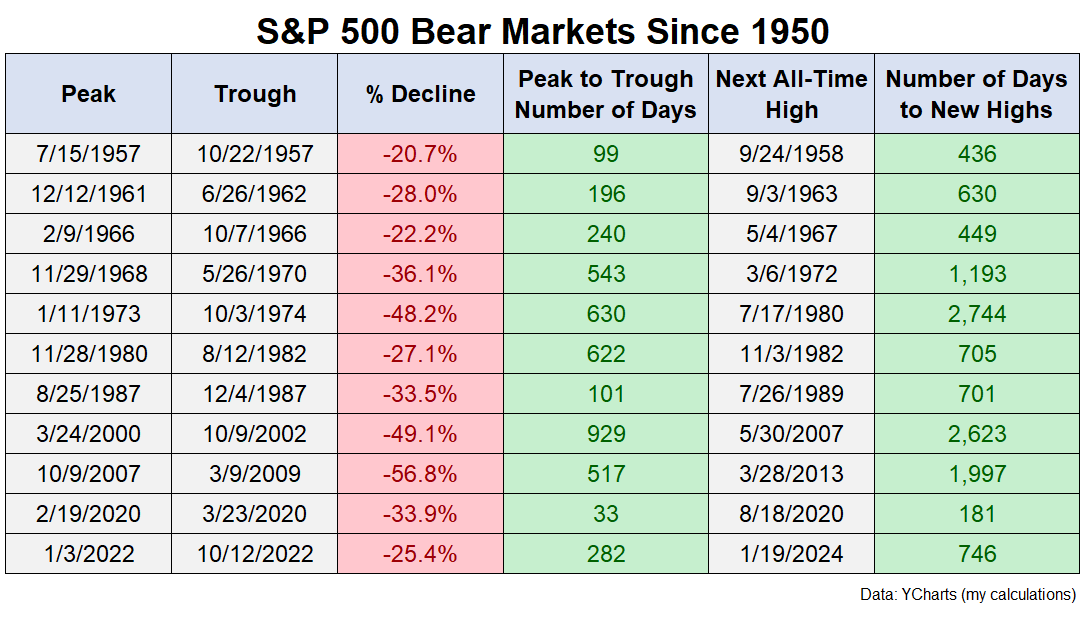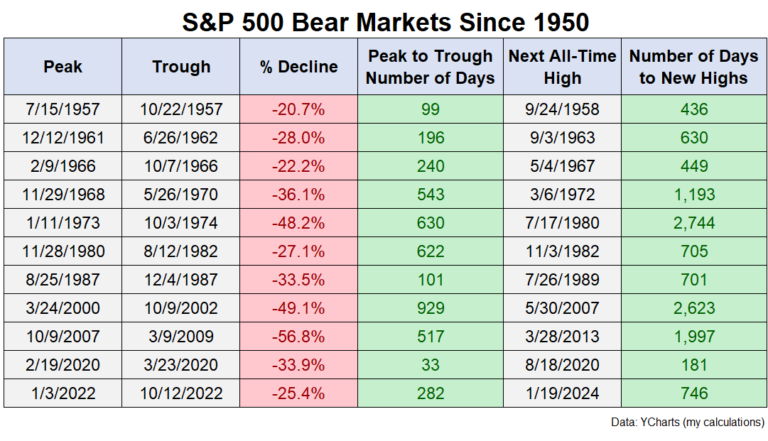It’s been a while but we’re back:

After a little more than two years, the S&P 500 finally took out the highs from January 2022 on Friday.
New all-time highs!
This bear market felt nasty in 2022 but it was fairly run-of-the-mill when compared with the biggest downturns over the past 70+ years.
Here’s an updated table of S&P 500 bear markets since 1950 along with the number of days it has taken to go peak-to-trough along with the prior peak-to-new highs:

The average bear market since 1950 has seen a drawdown of 35%, taking 381 days to bottom out and more than 1,100 days to go from the prior peak to new all-time highs.1
This is the kind of thing you should expect to happen every five or six years.2
Of course, we’ve now experienced two bear markets in four years but that’s how market averages work. You can’t set your watch to these things.
So what happens next?
I don’t know, of course, but it is interesting to look at what’s happened after the stock market hit new highs following bear markets in the past.
Here’s a look at the one, three, five and ten year returns3 from new highs following a bear market:

Most of the time new highs are followed by more new highs. The average one, three, five and ten year total returns following new highs were +16%, +27%, +59% and +206%, respectively.
That’s pretty good.
Really the only time new highs were hit and another bear market quickly followed was in 2007. New highs came in May 2007 while the peak for the Great Financial Crisis came in October of the same year.
The early 1970s experienced two dreadful bear markets in short order as well.
As always, there are exceptions to the rules when it comes to the markets.
I don’t know what happens from here. It’s anyone’s guess.
What I do know is that thinking and acting for the long term is typically rewarded when it comes to the stock market.
Staying the course still works.
Further Reading:
Staying the Course is Harder Than it Sounds
1If you were to take out the three biggest crashes (1973.1974, 2000-2002, and 2007-2009), the average old peak to new peak was an average of 614 days.
2Including the most recent one, there have been 11 bear markets since 1950 or one every six-and-a-half years.
3I wanted total returns here since they’re longer-term, but I didn’t feel like calculating the price returns to the exact day (it takes a lot of time). So these are total returns from the first full month after new highs (meaning the returns are probably even a tad understated). Close enough.
This content, which contains security-related opinions and/or information, is provided for informational purposes only and should not be relied upon in any manner as professional advice, or an endorsement of any practices, products or services. There can be no guarantees or assurances that the views expressed here will be applicable for any particular facts or circumstances, and should not be relied upon in any manner. You should consult your own advisers as to legal, business, tax, and other related matters concerning any investment.
The commentary in this “post” (including any related blog, podcasts, videos, and social media) reflects the personal opinions, viewpoints, and analyses of the Ritholtz Wealth Management employees providing such comments, and should not be regarded the views of Ritholtz Wealth Management LLC. or its respective affiliates or as a description of advisory services provided by Ritholtz Wealth Management or performance returns of any Ritholtz Wealth Management Investments client.
References to any securities or digital assets, or performance data, are for illustrative purposes only and do not constitute an investment recommendation or offer to provide investment advisory services. Charts and graphs provided within are for informational purposes solely and should not be relied upon when making any investment decision. Past performance is not indicative of future results. The content speaks only as of the date indicated. Any projections, estimates, forecasts, targets, prospects, and/or opinions expressed in these materials are subject to change without notice and may differ or be contrary to opinions expressed by others.
Wealthcast Media, an affiliate of Ritholtz Wealth Management, receives payment from various entities for advertisements in affiliated podcasts, blogs and emails. Inclusion of such advertisements does not constitute or imply endorsement, sponsorship or recommendation thereof, or any affiliation therewith, by the Content Creator or by Ritholtz Wealth Management or any of its employees. Investments in securities involve the risk of loss. For additional advertisement disclaimers see here: https://www.ritholtzwealth.com/advertising-disclaimers
Please see disclosures here.
